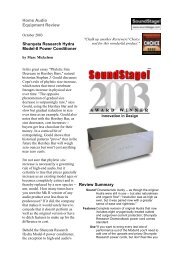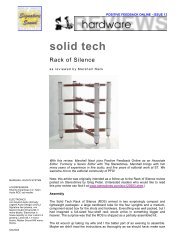Avantgarde Acoustic Uno Nano Loudspeaker - Audio Note Singapore
Avantgarde Acoustic Uno Nano Loudspeaker - Audio Note Singapore
Avantgarde Acoustic Uno Nano Loudspeaker - Audio Note Singapore
Create successful ePaper yourself
Turn your PDF publications into a flip-book with our unique Google optimized e-Paper software.
REPRODUCING THE RECORDED ARTS<br />
www.hifi plus.com<br />
Issue 62<br />
£4.99<br />
Different strokes for.... different folks<br />
Trumpet<br />
Major...<br />
<strong>Avantgarde</strong>’s<br />
Brilliant<br />
<strong>Uno</strong> <strong>Nano</strong><br />
Reclaiming The High-End<br />
Ayre KX-R<br />
conrad-johnson Classic<br />
DACs That Deliver<br />
Chord QBD-76<br />
PS <strong>Audio</strong> Digital Link<br />
Cambridge DacMagic
EQUIPMENT REVIEW<br />
Strange Fruit…<br />
<strong>Avantgarde</strong> <strong>Acoustic</strong> <strong>Uno</strong> <strong>Nano</strong> <strong>Loudspeaker</strong><br />
<strong>Avantgarde</strong>’s physically and visually<br />
impressive and imposing Trio<br />
speakers have been on the end of<br />
at least two of the top ten systems<br />
I’ve ever heard. There again, they<br />
probably also occupy a similar<br />
number of places in the equivalent<br />
lowerarchy… and there’s the rub.<br />
Their demands for lebensraum pale<br />
into insignificance when compared<br />
to the dictatorship they impose on<br />
matching systems and set up. This is<br />
one large speaker system you don’t<br />
want to buy without trying it at home!<br />
At least in part, that reflects<br />
the fact that, with horn designs,<br />
the strengths are so obvious, so<br />
pronounced, that the challenge<br />
becomes one of ameliorating their<br />
weaknesses rather than the other<br />
way around. And as great as the<br />
strengths are, the weaknesses can be<br />
catastrophic, making this not just a<br />
balancing act but a full on exercise<br />
in palliative care involving not just<br />
speaker design but the system, the<br />
room and in some cases even the<br />
listener.<br />
Which is what makes the <strong>Uno</strong><br />
<strong>Nano</strong> so intriguing. By full-range<br />
horn speaker standards it’s almost<br />
compact, even manageable. That<br />
makes it easier to transport and<br />
better able to deal with smaller<br />
rooms, making the whole home<br />
audition thing much less of a leap of<br />
faith, more an exercise in controlled<br />
anticipation. However, the way it<br />
deals with different systems remains<br />
to be seen…<br />
The three-way Trios present<br />
a “once seen, never forgotten”<br />
face to the world, their three,<br />
by Roy Gregory<br />
brightly coloured spherical horns<br />
unmistakable, the largest fully 950mm<br />
in diameter. But even that massive<br />
trumpet has limited low frequency<br />
extension, meaning that <strong>Avantgarde</strong><br />
offer an array of sub-woofer options<br />
to owners, culminating in a six-pack<br />
of active bass-horns. More modest<br />
systems can rely on a pair<br />
of more conventional,<br />
active, moving-coil<br />
subs. At the opposite<br />
end of the range, the<br />
company also offers<br />
smaller systems, again<br />
spherical horn, hybrid<br />
designs, but two-way,<br />
with less of the range<br />
handled by the horn<br />
drivers. The original<br />
Duo and <strong>Uno</strong> models<br />
employed vertical<br />
arrays, which were<br />
both attractive and<br />
bulky, their widely<br />
spaced elements<br />
taking up<br />
significant space.<br />
The <strong>Uno</strong> <strong>Nano</strong><br />
is a deliberate<br />
attempt to<br />
overcome this<br />
issue, and<br />
physically at<br />
least, it has to<br />
be considered<br />
a success.<br />
The sub-woofer<br />
cabinet, which doubles as the central<br />
structural element, is topped off<br />
by the 50cm midrange horn that<br />
dominates the appearance. The<br />
tweeter horn sits below and behind<br />
Reproduced from Hi-Fi+ Magazine, Issue 62<br />
www.hifiplus.com<br />
this, emerging from its own separate<br />
chamber in the top of, but visually<br />
contiguous with the bass unit. Three<br />
legs locate both the midrange horn<br />
and bass cabinet in space, while the<br />
speaker connections and sub-woofer<br />
controls are all on the rear.<br />
With any hybrid<br />
design, the key to<br />
success lies in<br />
the successful<br />
integration of<br />
the various<br />
components.<br />
In the<br />
case of the<br />
<strong>Uno</strong> <strong>Nano</strong>,<br />
the problem<br />
that presents<br />
is exacerbated<br />
by the fact that<br />
the horn-loaded<br />
midrange driver is not<br />
just super explicit, it<br />
is also super revealing<br />
due to the absence of<br />
any crossover and its<br />
direct connection to the<br />
amplifier. That’s great news<br />
from the point of view of<br />
musical immediacy and<br />
transparency, but potentially<br />
scary if you are a designer<br />
(or listener) used to having a<br />
crossover to hide a multitude<br />
of system sins. Fortunately,<br />
<strong>Avantgarde</strong> have been doing<br />
this for a while, and their subwoofer<br />
designs have come a long,<br />
long way since those early <strong>Uno</strong> and<br />
Duo models.<br />
The sub in the <strong>Nano</strong> is something<br />
of a tour de force. The basic
EQUIPMENT REVIEW<br />
ingredients are a pair of 250mm bass<br />
drivers per side, each pair driven by<br />
a conventional 250 Watt, Class AB<br />
amplifier. No wimpy switching power<br />
supplies or Class D output stages here,<br />
while the amp and drivers are tied<br />
together by a sophisticated real-time<br />
feedback loop to minimize distortion.<br />
There’s also a plethora of input and<br />
control options to ease interface and<br />
set-up. Inputs are either speaker level<br />
(via WBT connectors) or balanced<br />
XLR at line level. <strong>Avantgarde</strong> also<br />
supply a length of<br />
speaker<br />
wire to join<br />
the speaker<br />
terminals<br />
on the sub<br />
to the input<br />
terminals on<br />
the midrange<br />
horn, although<br />
proper bi-wiring<br />
with a matched<br />
pair of cables<br />
is a noticeably<br />
better solution.<br />
Rear panel controls<br />
allow you to set lowfrequency<br />
roll-off,<br />
high-pass frequency<br />
and level. There’s<br />
also an input selection<br />
switch and an earth<br />
post, while the power<br />
switch is a three-way<br />
one, allowing remote<br />
switch-on if required. With<br />
the physical relationship<br />
between the sub and its<br />
satellite horns defined by the<br />
speaker framework, no phase<br />
switch is needed.<br />
The trumpets that provide the<br />
horn loading are molded from ABS<br />
and painted in high-gloss automotive<br />
finishes. There’s a good range of<br />
standard finishes, but beyond these,<br />
almost anything is possible. The<br />
directly connected midrange driver is<br />
based around a 75mm cellulose dome<br />
and covers the range from 290Hz<br />
to 3kHz. The matching tweeter is<br />
connected via a simple, second order<br />
crossover to the amplifier, its 13cm<br />
horn matched to a special aluminium<br />
dome which is driven by a 3kg<br />
magnet assembly in order to match<br />
the 104dB output level of the rest of<br />
the system. You can<br />
begin to understand<br />
why the sub needs a<br />
pair of 250mm drivers<br />
and a 250 Watt amp<br />
to keep up!<br />
The whole thing<br />
stands 50cm wide,<br />
50 deep and 127<br />
tall, which is<br />
hardly compact<br />
in general<br />
terms, but<br />
represents a<br />
21cm reduction<br />
in height and a<br />
20cm reduction<br />
in depth over<br />
the original <strong>Uno</strong><br />
– which is not to<br />
be sniffed at. As<br />
noted, efficiency<br />
is extremely high<br />
at 104 dB, with a<br />
flat 8 Ohm load<br />
and 20 Hz to 20<br />
kHz bandwidth,<br />
making this<br />
a potent<br />
performer<br />
for one so<br />
small and<br />
attractive.<br />
Aside<br />
from<br />
the 68kg<br />
weight of each speaker,<br />
initial handling and positioning is<br />
disarmingly straightforward. The<br />
cabinet arrives with flat, felt covered<br />
feet on the bottom of each of its<br />
three legs, which makes placement<br />
and small adjustments a piece of<br />
cake. The three legs make leveling<br />
Reproduced from Hi-Fi+ Magazine, Issue 62<br />
www.hifiplus.com<br />
equally easy, which is just as well as<br />
a perfectly upright stance is essential<br />
(even more so than normal) to<br />
proper performance. I experimented<br />
at length with toe-in, only to discover<br />
that the trumpets need to point<br />
directly at the listener – as per the<br />
manual (<strong>Note</strong> to reviewer – RTFB).<br />
What is far more critical to the<br />
overall balance and soundstaging<br />
is the bass level and distance to the<br />
rear wall. In my room I started with<br />
the speakers positioned normally as<br />
regards rear spacing, with the subwoofer<br />
controls set at factory levels.<br />
A combination of tiny shifts fore and<br />
aft helped the overall balance, but<br />
the tonality and staging really locked<br />
in when I increased the bass level by<br />
one click (that’s about half a notch<br />
on the scale) and got the rear wall<br />
distance absolutely identical – an<br />
indication of just how potent the<br />
sub-woofer section of the <strong>Uno</strong> <strong>Nano</strong><br />
really is. With positioning finalized,<br />
it was down to the niceties of spiking<br />
or locking off the feet, wiring and<br />
system matching. Well, the first of<br />
these was straightforward enough…<br />
When it comes to hooking up the<br />
<strong>Nano</strong> to an amplifier, there are two<br />
rules: Rule one – if you have to single<br />
wire then connect to the terminals<br />
of the midrange unit, not the lower,<br />
more accessible terminals on the<br />
back of the bass cabinet. Rule two<br />
– then, run a set of identical cables<br />
down to the bass unit; the straps<br />
supplied by <strong>Avantgarde</strong> should be<br />
considered in the same light as the<br />
nasty metal plates that come with<br />
most other bi-wirable speakers! And<br />
use the best cable you can – you<br />
will hear the difference. Don’t even<br />
consider bi-wiring until you’ve got<br />
the best cables you can. Then, and<br />
only then, it makes sense.<br />
Which brings us, finally, to<br />
the vexed question of matching<br />
amplification. <strong>Avantgarde</strong> supplied<br />
one of their Model Three integrated<br />
amplifiers along with the <strong>Uno</strong>
EQUIPMENT REVIEW<br />
<strong>Nano</strong>s – which proved to be<br />
something of a mixed blessing. One<br />
of the most elegant and attractive<br />
units I’ve recently laid hands on,<br />
it is also shockingly effective in<br />
combination with the company’s<br />
speakers. Its modest power output,<br />
dimensions and price, combined with<br />
an innovative cascode output stage<br />
and minimal feedback deliver exactly<br />
what the <strong>Nano</strong>s demand – and the<br />
Duos, Trios and all the rest. Now,<br />
I’m not saying that this is the<br />
only amp you can use with<br />
the <strong>Avantgarde</strong> speakers, but<br />
the only other amps I had<br />
in the house that sounded<br />
better than the Model Three<br />
were the Vacuum State<br />
mono-blocs, at around<br />
three times its £4750 asking<br />
price. So, there are amps that<br />
can get even better sound<br />
out of the <strong>Nano</strong>s, but whether<br />
they make economic sense is<br />
another matter – as it ever was with<br />
horn speakers. After all, remove the<br />
demand for power delivery and load<br />
tolerance and the amp’s job gets a lot<br />
easier, and easier still as the speakers<br />
get larger, more efficient and more<br />
expensive, turning conventional hi-fi<br />
logic on its head. Just as well then,<br />
that the Model Three is as attractive<br />
and svelte as it is!<br />
By now you’ll have gathered that<br />
the <strong>Nano</strong>s have to be something<br />
special in order to justify this<br />
preamble. Leaving their looks aside,<br />
which I love but others might not<br />
find so appealing, it’s the sound<br />
that matters and it’s here that the<br />
<strong>Avantgarde</strong>s really score. In a world<br />
of me-too speaker designs, here’s<br />
a product that raises the bar just as<br />
high sonically as it does visually.<br />
Of course, it’s all about integration<br />
and getting the speaker to work as a<br />
single, coherent whole, but the effort<br />
that takes is well worthwhile, the<br />
rewards spectacularly engaging and<br />
musical. There’s a strange, nagging<br />
familiarity about their sound that<br />
those who listen mainly to hi-fi<br />
might take time to place; it’s the<br />
sound of life…<br />
Maybe it’s the proximity of the<br />
horn-loaded drivers, or maybe that<br />
they don’t try to cover too much<br />
of the range, but coherence, the<br />
traditional Achilles’ Heel of horn<br />
designs, just isn’t a problem here.<br />
Get the bass integrated properly and<br />
the quality of the sound<br />
that results<br />
is both<br />
remarkably<br />
consistent<br />
and spatially<br />
seamless, with<br />
no awkward<br />
joints or shelves<br />
in the sound<br />
produced. Of<br />
course, the bass<br />
drivers can’t match<br />
the speed and attack<br />
of the mid-band, but<br />
unless you go looking for<br />
the discontinuity you’ll not notice it.<br />
Sparse, acoustic recordings reveal it;<br />
solo piano suffers a loss of percussive<br />
impact to left hand notes when<br />
compared to the clarity and precision<br />
of the right, but timing and melodic<br />
flow are undisturbed. The Jean Muller<br />
disc of Chopin pieces on Turtle<br />
Reproduced from Hi-Fi+ Magazine, Issue 62<br />
www.hifiplus.com<br />
Records reveals both the quicksilver<br />
agility of the playing, the leading<br />
edge precision of the notes, their<br />
pattern and placing, and also the way<br />
the speakers let their weight fall on<br />
the first half of the note. It’s a subtle<br />
emphasis that brings a lightness of<br />
touch to the<br />
music, which is<br />
very much a<br />
part of<br />
the <strong>Nano</strong><br />
experience.<br />
Staging is<br />
impressive, again<br />
a traditional horn<br />
weakness, too often<br />
undermined by limited<br />
low frequency extension. Here that<br />
isn’t a problem, the subs delivering<br />
all the bottom end you need. The<br />
result has tremendous scale and<br />
width, although depth tends to be<br />
curtailed. This is as much a result<br />
of the way the sound seems to sit
EQUIPMENT REVIEW<br />
around instruments, as any real<br />
spatial foreshortening. What you hear<br />
is the air immediately surrounding<br />
each player, rather than the acoustic<br />
as a whole. The result is a pleasing<br />
sense of air and space, even if you<br />
can’t tell precisely where that space<br />
ends, lacking as it does, clearly<br />
defined boundaries.<br />
But enough of looking<br />
for problems; let’s<br />
look at the <strong>Nano</strong>s’<br />
considerable musical<br />
strengths. Like any horn<br />
based design, they offer<br />
an impressive sense of<br />
immediacy and dynamic<br />
range. Add that to their deft<br />
touch and effortless sense<br />
of weight and scale and<br />
the result is a powerful<br />
and impressive performance<br />
that’s full of life, presence and<br />
detail. Move up from Chopin<br />
to Murray Perahia playing Bach<br />
and those strengths come into their<br />
own. Periahia’s fluid lines, set<br />
against the complexity of the<br />
orchestration, create<br />
wonderful patterns<br />
and contrasts,<br />
his subtle<br />
weighting<br />
of notes<br />
and phrases<br />
revealed despite the<br />
quickness and lightness of his<br />
touch. The precision of both<br />
his playing and the Academy’s<br />
accompaniment are beautifully<br />
unraveled, leaving you to marvel<br />
at the sublime beauty of the musical<br />
structures. Perahia’s cascades of<br />
crisp, rapid notes are unconstrained,<br />
joyously vibrant and percussive, while<br />
the discipline in this most complex<br />
of music is a thing of soaring,<br />
symmetrical wonder rather than a<br />
limitation to be overcome. It is this<br />
effortless separation and organization,<br />
the way the speakers reveal the<br />
juxtaposition between phrases,<br />
between notes within phrases that<br />
makes the <strong>Avantgarde</strong>s’ musical<br />
delivery so compelling.<br />
Does that slight tonal lightness<br />
bother me? I have to say, no. Soprano<br />
voices have a subtle, almost piping lilt<br />
to them that brings<br />
superb clarity and<br />
precision to the<br />
singing, a quality<br />
that, once<br />
applied to the<br />
earthier end<br />
of the vocal<br />
range,<br />
could be<br />
described as<br />
leaning to<br />
the spit and<br />
tonsils school<br />
of delivery, rather<br />
than really letting you hear a singer’s<br />
chest. Likewise, pianos take on a<br />
Steinway-esque crispness and attack,<br />
irrespective of their DNA. Purists<br />
might demur, but play less than<br />
wonderful recordings and the ability<br />
to sort through the mush more than<br />
Reproduced from Hi-Fi+ Magazine, Issue 62<br />
www.hifiplus.com<br />
compensates. Cue up Steve Earle’s<br />
Copperhead Road and you’ll see<br />
what I mean. This monumental slab<br />
of towering roots rock is all about<br />
power, impact and musical swagger.<br />
The heavy drumbeats that kick<br />
the title song along, that crashing,<br />
rumbling, landslide of a chord that<br />
opens the track proper, have real<br />
weight but attack and texture too.<br />
And if Earle’s vocals lack that last<br />
abrasive, gravely edge, the ability to<br />
unravel the lyrics and articulate the<br />
all-important story behind each song<br />
is more than adequate compensation.<br />
The musical results are moving and<br />
motive; much, much more subtle<br />
than the stacked power chords and<br />
dense mix would have you believe.<br />
Suddenly it’s all about the depth of<br />
feelings, the power of emotion, rather<br />
than simply turning the volume up<br />
to 11.<br />
The direct connection of the mid<br />
driver is largely responsible for the<br />
tactile sense of attack and life in the<br />
playing – whether it’s renaissance<br />
lute, Charlie Byrd or one of Jimmy<br />
Page’s less restrained moments.<br />
The lack of a subtractive<br />
network allows the notes to<br />
flow unimpeded, their pitch,<br />
placement and dynamic<br />
spacing utterly explicit.<br />
The result is music with both<br />
delicacy (when required) and a<br />
sense of purpose. Less obvious, but<br />
just as important to the overall effect,<br />
is the surefootness, the unambiguous<br />
nature of the rhythm, pace and timing<br />
of musical phrases and passages.<br />
Dance music was a joy – and I’m not<br />
just talking electro-pop here. Just<br />
stop and consider how much music<br />
was written for dancing, or written<br />
based on the rhythms and patterns of<br />
formal dances. These Avantegardes<br />
leave you in no doubt, unearthing<br />
the strands and steps of musical<br />
structure from beneath the densest<br />
of orchestration. Yet the precision<br />
of their delivery never imposes or
EQUIPMENT REVIEW<br />
restricts, their poise never constrains.<br />
Instead it gives the music a grounded<br />
stability and confidence. You never<br />
doubt where it’s come from, you<br />
never wonder where it’s going, you<br />
simply let it carry you there.<br />
Tick all the boxes that go with<br />
these speakers and<br />
you’ll quickly and rightly<br />
realize that Jazz will be<br />
meat and drink to them.<br />
Yet the same rhythmic<br />
integrity, speed and<br />
clarity, attack and<br />
separation that<br />
make sense of the<br />
most convoluted<br />
of free-form<br />
meanderings, convey<br />
other forms of music<br />
with equal ease.<br />
Sure, spherical horns<br />
do have a way with<br />
trumpets and other<br />
brass instruments<br />
– beautifully<br />
breathy and at<br />
the same time<br />
uninhibited – but<br />
if ever a speaker<br />
revealed the lie<br />
in the notion<br />
that certain<br />
products<br />
favour<br />
particular<br />
types of<br />
music,<br />
then the<br />
<strong>Nano</strong> is it.<br />
If a product<br />
will only play<br />
one musical genre<br />
it is because that music fails to show<br />
up its weaknesses. I’ve spent most of<br />
this review talking about the music<br />
that the <strong>Uno</strong> <strong>Nano</strong> shouldn’t play<br />
– but it most certainly does. In the<br />
time I’ve had them at home they’ve<br />
treated me to a plethora of surprising<br />
and memorable musical moments,<br />
from a captivating and poignant Cosi<br />
Fan Tutti to raw, unpolished live<br />
tracks from Steve Earle, the Heifetz/<br />
Piatigorsky chamber recordings to<br />
Wilco’s Yankee Hotel Foxtrot and the<br />
Mingus Sextet at Cornell. Every time<br />
I think I’ve fastened on what these<br />
speakers do (or don’t do) they go<br />
and surprise me. Every time I unearth<br />
some aged gem I’ve not listened to in<br />
years, they remind me just<br />
why I bought it in the<br />
first place.<br />
The <strong>Uno</strong> <strong>Nano</strong> is<br />
a far from<br />
perfect<br />
speaker<br />
– at least<br />
in the<br />
classical<br />
sense.<br />
They don’t<br />
look like other<br />
speakers and<br />
for the<br />
most part<br />
they don’t<br />
sound like<br />
them either<br />
– by which<br />
I mean, they<br />
don’t suffer<br />
the muddled,<br />
constricted and<br />
turgid response<br />
that’s all too<br />
recognizable in<br />
more “conventional”<br />
approaches. They<br />
play loud (actually,<br />
make that really loud),<br />
they play soft; they have<br />
dynamic range that gets<br />
close to life and scale<br />
and weight that’s sufficient to all but<br />
the most warped and unreasonable<br />
purpose. They offer that all-important<br />
bandwidth without the oft-associated<br />
demands for power and if they<br />
are picky about partnering amps<br />
at least that pickiness doesn’t also<br />
impose a high price. You can go<br />
looking for their tonal aberrations,<br />
Reproduced from Hi-Fi+ Magazine, Issue 62<br />
www.hifiplus.com<br />
their discontinuities, but you know<br />
what – more often than not you’ll<br />
find yourself pulled away from that<br />
quest and into the music instead. The<br />
formality and correctness of Bach<br />
will leave them unfazed (and you<br />
charmed), the delicacy of solo female<br />
vocal allows them to open their<br />
tubes (and you to marvel at a singer’s<br />
control and technique). It’s not long<br />
before you stop trying to catch them<br />
out and simply catch on to what<br />
they do – which is cut straight to the<br />
essential heart of the music. Listen<br />
and you’ll remember. <strong>Avantgarde</strong>’s<br />
smallest full-range speaker is both<br />
challenging and disarming, which<br />
is no bad thing to be. Those with<br />
open minds will welcome them<br />
with open arms.<br />
TECHNICAL SPECIFICATIONS<br />
Type: Hybrid spherical horn<br />
with active bass<br />
Driver Complement: 1x 13cm treble horn<br />
1x 50cm midrange horn<br />
2x 25cm pulp-cone bass<br />
Bass Amplifier: 250 Watt Class AB<br />
Crossover Frequencies: 290Hz and 3kHz<br />
Sensitivity: 104dB<br />
Impedance: 8 Ohms<br />
Bandwidth: 20Hz – 20kHz ±3dB<br />
Dimensions (WxHxD): 500x1270x520mm<br />
Weight: 68kg ea.<br />
Prices -<br />
<strong>Uno</strong> <strong>Nano</strong> <strong>Loudspeaker</strong>s: £9000<br />
Model 3 Integrated Amp: £4750<br />
UK Distributor:<br />
G T <strong>Audio</strong><br />
Tel. (44)(0)1895 833099<br />
Net. www.gtaudio.com<br />
Manufacturer:<br />
Avantegarde <strong>Acoustic</strong> GmbH<br />
Tel. (49)(0) 6254 306100<br />
Net. www.avantgarde-acoustic.de



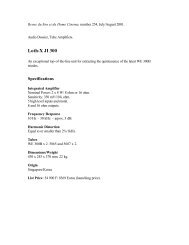
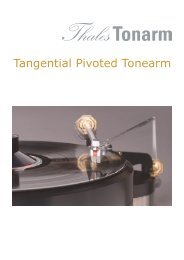
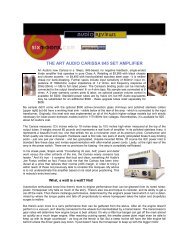
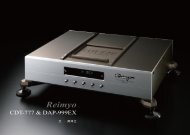

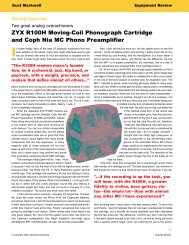
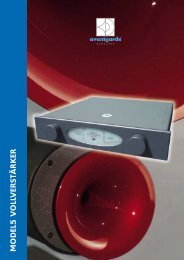
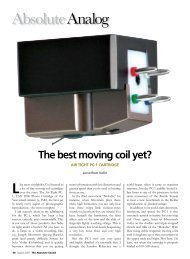
![DAP-999 EX Limited [pdf] - Audio Note Singapore](https://img.yumpu.com/27191044/1/190x253/dap-999-ex-limited-pdf-audio-note-singapore.jpg?quality=85)
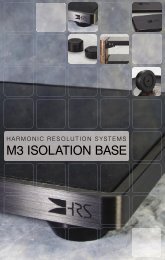
![Harmonix CS-120 Improved-Version [pdf]](https://img.yumpu.com/24411255/1/184x260/harmonix-cs-120-improved-version-pdf.jpg?quality=85)
